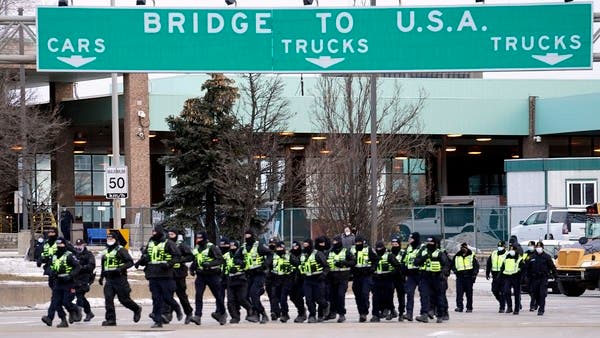WINDSOR, Ontario, (Reuters) – Canadian police began clearing protesters blocking a key bridge linking Canada and the United States today, more than 12 hours after a court order came into effect that ended a blockade that had snarled international trade.
The Ambassador Bridge, North America’s busiest land border crossing, had no traffic flowing for the fifth straight day this morning. About 15 trucks, cars and pick-up vans blocked traffic in both directions, choking the supply chain for Detroit’s carmakers.
“We urge all demonstrators to act lawfully & peacefully,” Windsor Police said in a Twitter post, asking commuters to avoid the areas affected by the demonstrations.
Police in black uniforms with yellow vests moved behind the protesters’ vehicles, forming a line across the bridge entrance and yelling at protesters to move. The number of demonstrators had thinned from about 200 on Friday night to roughly two dozen early Saturday.
Protesters closest to the bridge were seen moving back peacefully.
The “Freedom Convoy” protests, started in the capital Ottawa by Canadian truckers opposing a vaccinate-or-quarantine mandate for cross-border drivers, entered its 16th day on Saturday.
The protests have inspired similar convoys and plans in the United States, France, New Zealand and Australia.
In Paris, French police fired tear gas at demonstrators on the Champs Elysees avenue on Saturday shortly after a convoy carrying protesters against COVID-19 restrictions made it into the capital.
The protests in Canada have morphed into a wider protest against COVID restrictions and the Canadian government.
Protests have spread to three border points: the Ambassador Bridge, strangling trade between the two countries, and two smaller crossings in Alberta and Manitoba.
More protests are expected on Saturday. East of Ottawa, people were expected to gather in Fredericton in the province of New Brunswick for a weekend demonstration. Local police said officers were stationed at entrances to the city to ensure traffic can flow freely. The financial capital Toronto was also bracing for a second weekend of protests.
A convoy of motorists in the United States is planning to head to the waterfront in Port Huron, Michigan, in support of protesters in Canada. Another U.S. group said two separate vehicle convoys will converge this weekend at the Peace Bridge, another U.S.-Canadian border crossing in Buffalo, New York.
Ford, the second-largest U.S. automaker, said on Friday it had temporarily halted work at its assembly plant in Ohio. General Motors and Toyota Motor Co also announced new production cuts. Companies have diverted cargo to stem losses amid production cuts.
The estimated loss from the blockades just to the automobile industry could be as high as $700 million, based on IHS Markit’s data, which puts the daily flow in vehicles and parts at $141.1 million day in 2021.
Prime Minister Justin Trudeau has come under pressure from opposition party leaders to intervene, while U.S. President Joe Biden’s administration urged his government to use federal powers.
Trudeau has promised Biden quick action to end the crisis.
Trudeau is scheduled to chair a meeting of his top advisors on Saturday, called the Incident Response Group, to discuss the ongoing blockades, according to his office.






